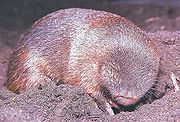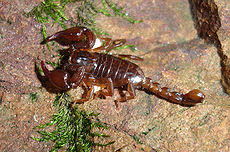
Xerocole
Encyclopedia
Xerocoles are animals adapted to live in a desert
.
Under the scorching rays of sun, the arid and baked sands of deserts may appear to be devoid of animal life. But surprisingly a large number of animal species may thrive there. The animals are either drought evaders or drought resistors. Drought evaders make their appearance only when rain sets in, remaining dormant in the interim. All sorts of specialized animals, ranging from insects to mammals are found in a desert. Such animals are well adapted to desert life.
 *To avoid water evaporation:
*To avoid water evaporation:
The Māori name for Rainbow Falls on the Kerikeri River is Waianiwaniwa which means Waters of the Rainbow. They are one of the most visited attractions in the district. It is possible to drive almost to the falls, with walking also possible from the Stone Store basin.
The Māori name for Rainbow Falls on the Kerikeri River is Waianiwaniwa which means Waters of the Rainbow. They are one of the most visited attractions in the district. It is possible to drive almost to the falls, with walking also possible from the Stone Store basin.
Desert
A desert is a landscape or region that receives an extremely low amount of precipitation, less than enough to support growth of most plants. Most deserts have an average annual precipitation of less than...
.
Under the scorching rays of sun, the arid and baked sands of deserts may appear to be devoid of animal life. But surprisingly a large number of animal species may thrive there. The animals are either drought evaders or drought resistors. Drought evaders make their appearance only when rain sets in, remaining dormant in the interim. All sorts of specialized animals, ranging from insects to mammals are found in a desert. Such animals are well adapted to desert life.
- Surface grazer animals make use of water available from desert water holes and conserve it for long periods of time.
- Desert rabbits, tortoises, and wood rats (Neotoma) eat succulent plants for their water needs and do not drink water even if it becomes available.
- Jerboas, Kangaroo RatKangaroo ratKangaroo rats, genus Dipodomys, are small rodents native to North America. The common name derives from their bipedal form: as they hop in a manner similar to the much larger kangaroo, although they are not related...
s (Dipodomys), pocket mice (PerognathusPerognathusPerognathus is a genus of pocket mouse. Like other members of their family they are more closely related to pocket gophers than to true mice.-Characteristics:...
) and other desert rodents depend entirely on metabolic waterMetabolic waterMetabolic water refers to water created inside a living organism through their metabolism, by oxidizing energy-containing substances in their food...
produced in their body during oxidation of dry seeds and vegetation. - Carnivorous animals get required water from the bodies of their prey.
- The skin of certain animals like sand lizards or Moloch horridus is hygroscopic and absorbs water like blotting paper.
Water Conservation
Xerocoles have developed numerous water conservation adaptations.
-
- The number of sweat glands are reduced or absent.

- ScorpionScorpionScorpions are predatory arthropod animals of the order Scorpiones within the class Arachnida. They have eight legs and are easily recognized by the pair of grasping claws and the narrow, segmented tail, often carried in a characteristic forward curve over the back, ending with a venomous stinger...
s and reptiles have developed almost impermeable outer coverings. - The thorny devilThorny DevilThorny Devil is an Australian lizard. It is also known as the Thorny Dragon, Mountain Devil, Thorny Lizard, or the Moloch and is the sole species of genus Moloch....
collect moisture in the dry desert via night-time condensation of dew which forms on the skin and is channelled to the mouth in hygroscopic grooves between its spines. During rain events, capillary actionCapillary actionCapillary action, or capilarity, is the ability of a liquid to flow against gravity where liquid spontanously rise in a narrow space such as between the hair of a paint-brush, in a thin tube, or in porous material such as paper or in some non-porous material such as liquified carbon fiber, or in a...
allows the lizard to suck in water from all over its body. - Scales and spines are developed on the exposed surfaces of animals like sand lizards (such as Moloch horridus) and horned lizards.
- The carapaces of desert insects are waxy to prevent water from escaping.
- CamelCamelA camel is an even-toed ungulate within the genus Camelus, bearing distinctive fatty deposits known as humps on its back. There are two species of camels: the dromedary or Arabian camel has a single hump, and the bactrian has two humps. Dromedaries are native to the dry desert areas of West Asia,...
s can tolerate high temperature and can control loss of water through sweating. Water lost from their body is not from blood but from other tissues. They can lose 30% of their body weight without showing sign of distress.
- The number of sweat glands are reduced or absent.
- To avoid loss of moisture during evaporation:
- Many desert animals cool exhaled air in their noses before it is expelled out through nostrils. As a result moisture condenses in the nose and is not lost as water vapor.
- To avoid loss of water during excretion:
- This is brought about by excreting concentrated urine or urine in semisolid state. Desert rats and kangaroo rats excrete urine that contain 24% urea. The reptiles, insects, and birds excrete body waste in the form of uric acidUric acidUric acid is a heterocyclic compound of carbon, nitrogen, oxygen, and hydrogen with the formula C5H4N4O3. It forms ions and salts known as urates and acid urates such as ammonium acid urate. Uric acid is created when the body breaks down purine nucleotides. High blood concentrations of uric acid...
and no water is lost.
- This is brought about by excreting concentrated urine or urine in semisolid state. Desert rats and kangaroo rats excrete urine that contain 24% urea. The reptiles, insects, and birds excrete body waste in the form of uric acid
Other methods of conserving water
- Burrowing animals come out of their burrow in late night or early morning when moisture content in their burrow and outside atmosphere is almost equal. Some animals plug the mouth of their burrow during the day.
- Some desert animals, known as drought evaders, are active only for a brief period of the year when water and food is available. The period of inactivity is called estivationEstivationAestivation is a state of animal dormancy, characterized by inactivity and a lowered metabolic rate, that is entered in response to high temperatures and arid conditions...
which is like the opposite of hibernationHibernationHibernation is a state of inactivity and metabolic depression in animals, characterized by lower body temperature, slower breathing, and lower metabolic rate. Hibernating animals conserve food, especially during winter when food supplies are limited, tapping energy reserves, body fat, at a slow rate...
.
The Māori name for Rainbow Falls on the Kerikeri River is Waianiwaniwa which means Waters of the Rainbow. They are one of the most visited attractions in the district. It is possible to drive almost to the falls, with walking also possible from the Stone Store basin.
The Māori name for Rainbow Falls on the Kerikeri River is Waianiwaniwa which means Waters of the Rainbow. They are one of the most visited attractions in the district. It is possible to drive almost to the falls, with walking also possible from the Stone Store basin.
Protection against scorching sun
- Xerocole animals possess a thick hide or protection armor of scales, spines, or dermal scutes.
- Long legs of desert animals lift their body above the ground to avoid direct contact of the body with burning sands.
- Large ears, such as the ones found on an african elephant help it cool down in places such as the sahara desert. Because the blood vessels in its ears are more exposed to the air, allowing the blood to be cooled down and then circulated around its body to help lower its body temperature in its hot environment. They can also be good for predators such as servalServalThe serval , Leptailurus serval or Caracal serval, known in Afrikaans as Tierboskat, "tiger-forest-cat", is a medium-sized African wild cat. DNA studies have shown that the serval is closely related to the African golden cat and the caracal...
, in listening to tiny vibrations in the sand to pin point the exact location of their prey in the hidden grass or ground. - Burrowing habits of animals, such as burrowing owlBurrowing OwlThe Burrowing Owl is a tiny but long-legged owl found throughout open landscapes of North and South America. Burrowing Owls can be found in grasslands, rangelands, agricultural areas, deserts, or any other open dry area with low vegetation. They nest and roost in burrows, such as those excavated...
s or prairie dogs help protect them from the scorching rays of the sun for a considerable period of time. - Some desert animals have acclimatized to the high temperature of the desert. Beetles and lizards in general can tolerate temperatures much higher than can be tolerated by human beings.
Protection against sand storms
- Nostrils are either reduced to small pin holes or they are protected with complicated valves.
- Camels can close up their nostrils to keep sand out. And their long eyelashes help protect their eyes from blowing sands. However during sandstorms they will shut their eyes completely and can still see well enough through their thin eyelids to keep moving.
- In sandswimming lizards, the nostrils are directed upward; this may provide a protection from clogging by wind blown sands.
- In the lizard MabuyaMabuyaMabuya is a genus of long-tailed skinks nowadays restricted to species from the Americas. The American mabuyas are primarily carnivorous, though many are omnivorous. Formerly, many Old World species were placed here, as Mabuya was a kind of "wastebasket taxon"...
, an enlarged transparent lower eyelid, or nictitating membraneNictitating membraneThe nictitating membrane is a transparent or translucent third eyelid present in some animals that can be drawn across the eye for protection and to moisten it while maintaining visibility. Some reptiles, birds, and sharks have a full nictitating membrane; in many mammals, there is a small...
, can cover the eyes thereby protecting them from sand without obstructing vision. In the lizard AblepharusAblepharusThe skink genus Ablepharus contains the common snake-eyed skinks. Their name refers to the fact that their eyelids have fused to a translucent capsule; like snakes, they thus cannot blink.-Species:* Twin-striped Skink...
, the lower eyelid permanently covers the eyes and is fused with the lower margin of the eyelid. In camels the eyes are high on the head and are protected by long thick eyelashes. - The ear openings of desert animals, if they exist, are either small, protected by fringes, scales or hairs.
Speed
Since desert animals have to move far and wide in search of food and water, the majority of them have great speed. The limbs are specialized and adapted to walk on sand.- Limbs are often long.
- Desert cats paws have wide soles thickly covered with fur which enables them to walk comfortably even on hot sand.
- Legs of ostriches are padded with hair, muscular and developed.
- Camels have extra padding on the undersurface of their feet.
- Some lizards like CrotaphytusCrotaphytusClassification of the genus Crotaphytus, a type of lizard.-Genus Crotaphytus:*Venerable Collared Lizard, Crotaphytus antiquus*Desert Collared Lizard, Crotaphytus bicinctores*Common Collared Lizard, Crotaphytus collaris...
and Callisaurus have longer hind feet for fast running on sandy surfaces.

